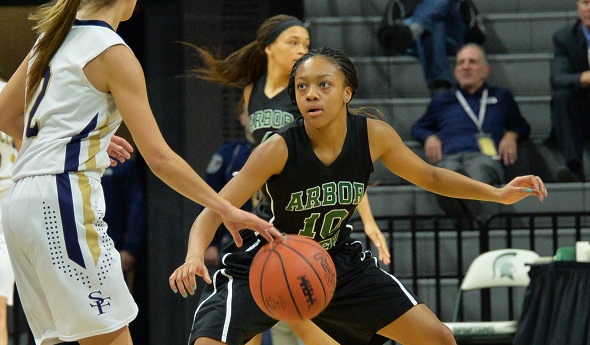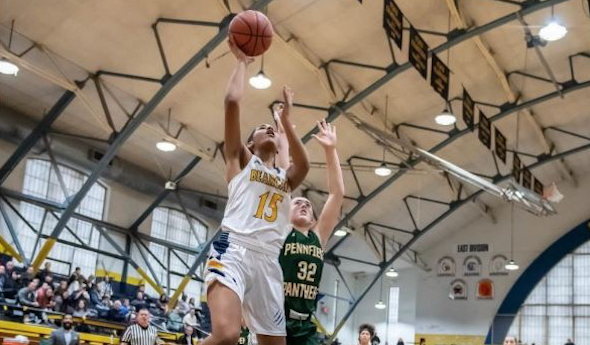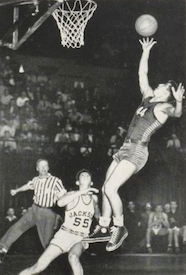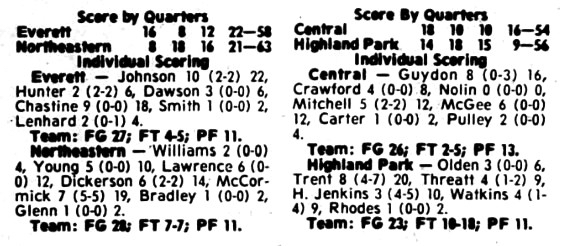
Experience, 'D' Fuel Arbor Prep's Rise
By
Chip Mundy
Special for Second Half
January 27, 2017
By Chip Mundy
Special for Second Half
YPSILANTI – The message for girls basketball players at Ypsilanti Arbor Prep is clear: If you don't play defense with a passion, you're not going to get on the court very often.
 “They've bought into it,” coach Rod Wells said. “Anybody who comes into our system, they tell them, 'You've got to play D, or you're not going to play.'”
“They've bought into it,” coach Rod Wells said. “Anybody who comes into our system, they tell them, 'You've got to play D, or you're not going to play.'”
It is paying off in a big way. Arbor Prep, a charter school which opened just six years ago, is coming off a Class C championship and currently is 13-0 and ranked No. 1 in Class B by The Associated Press. Three years ago, Arbor Prep was a quarterfinalist in Class B, and the following year it lost in the Class C semis.
Five of the six players who have started this season are seniors, and the Gators are allowing just 26.5 points per game while scoring 66.9.
“We press a lot, but to win a state championship we knew we had to change,” Wells said. “Last year, we pressed, but we understood you have to play great half-court defense. Our girls know how to play half-court defense.
“Some teams can handle the press, and some can't – most teams can't – but we understand some of the good teams are going to be able to break us. We really work on our half-court defense, which a lot of people don't give us respect for. They just think we're a pressing team, but we play a sagging man-to-man defense. We got it from Wisconsin. We don't let people get into the paint. We put pressure on the ball.”
Senior guards Adrienne Anderson and Ro'zhane Wells are the sparks to the defense. Anderson typically guards the opponent's top scorer, while Wells – a point guard - draws the opposing point guard. Anderson leads the team with 3.8 steals per game, and Wells checks in with 3.1. Additionally, forward/center Cydney Williams is averaging 3.2 steals per game, and senior forward Lauryn Carroll is at 2.6.
“Ro'zhane and Adrienne are the two best defenders on the ball in the state of Michigan,” Wells said. “They put so much pressure on the ball that teams can't get into their offense. The rest of the girls play their roles. I brag about those two girls, and now the other girls love defense so much they say, 'What about us, Coach? We're doing it, too.' It's true, they are getting a lot better, but those two are special.
“Our defense is what makes us go. The tenacity and working hard – they work so doggone hard. They have fun, but they understand that we don't want to give up baskets. Our thing is that if you play great defense and give everything you have on defense, on offense I'll let you do your thing. We run a structured offense, but I give you freedom to shoot the ball. If we play great defense, we'll get it back.”
New school, new program
Arbor Prep, a charter school, opened in the fall of 2011 for students from ninth through 12th grades. Wells, who previously had coached at Milan and Ann Arbor Skyline, started the girls basketball program that season. And it was an instant success, although many did not see it that way.
The Gators won their first 15 games with mostly sophomores and freshmen, but the schedule was not overly competitive, and Arbor Prep finished 17-2.
“It was a real challenge,” Wells said. “We made up our schedule at the last minute, and that was a challenge right there. People were saying that we weren't for real and not playing anybody.
“What we did do was get the girls to believe and play hard. We had no expectations. We didn't know we would end up 17-2; we just wanted to play basketball. When we went 17-2, the girls saw that hard work can pay off.”
Respect was soon to follow.
“The next year we beat Benton Harbor, and the following year we beat Country Day,” Wells said. “I think when we beat those two schools, people believed we were for real. Then I looked in the paper. Whoever was ranked or was a big-time school in girls basketball, I called them up and asked if they wanted to play.
“Inkster was the state champs the year before, and we lost by five to them at our place. Their coach was like, 'I can't believe this; you have all freshmen and sophomores.'”
As the program progressed, it seemed to take a step every season. And Wells said each step was a learning process, especially the season-ending losses in the Quarterfinals and Semifinals.
“We learned something from each loss,” Wells said. “One year I thought we weren't strong enough physically. The team had a big girl, and she killed us, but we didn't play team defense. We let our big go against her. The next year, we scheduled teams that had bigs, and we learned to play team defense against that big, and we got better. That was our lesson.
“The following year we lost to Flint Hamady. We had a bad first quarter and a bad second quarter, and we outplayed them the last two quarters. We made six of 16 free throws. Our lesson from that is we break things down every quarter. We want to win every quarter. You can have all the good work all year and then get behind 10 in one quarter, you waste your whole season. If we play a good team or a bad team, we concentrate on winning each quarter. We've lost two quarters this year.”
On the run to the Class C title last year, the Gators lost twice. Wells said lessons were learned in both losses.
 “We lost to Ann Arbor Huron, and my girls just didn't play well, and we lost to Country Day after having a 16-point lead,” he said. “Both of those losses helped to get the girls right. The loss to Country Day was the turning point. They thought I was going to run them in practice and all that, and no, let's just bounce back and do what we do. We blew it, so let's move on.”
“We lost to Ann Arbor Huron, and my girls just didn't play well, and we lost to Country Day after having a 16-point lead,” he said. “Both of those losses helped to get the girls right. The loss to Country Day was the turning point. They thought I was going to run them in practice and all that, and no, let's just bounce back and do what we do. We blew it, so let's move on.”
And the Gators moved on to the Breslin Center. They had been there the year before in the Semifinals, and Wells believes that 2015 experience was vital to their success.
“I knew that they were going to win that day,” he said. “They had that look in their eye, and they felt the pain from the year before. They saw the (Detroit Martin Luther) King girls crying after the Class A Finals, which were right before us. I didn't even need to have a speech.
“They had been there before. You walk into the Breslin, and it's a different experience. This time, they were like, 'This is our locker room, this is where we're going, there's the pictures on the wall, let's play ball.' No surprises. They were absolutely ready.”
Senior forward/center Cydney Williams remembers feeling overwhelmed with her first visit to Breslin and how it changed on the second trip.
“It was like, 'Wow, this is a big arena,'” she said. “All the lights were on us, we were on live TV, there was a whole bunch of noise, and we couldn't hear coach on the sideline. We had to talk to each other more on the court and zone out of the crowd.
“Last year, we just had that one goal that we weren't going to feel like we felt the year before.”
Arbor Prep is no longer that new program that plays a weak schedule and has its doubters.
It has a winning resume, and this year so much experience and talent that no individual player can put up eye-popping numbers because of the balance. In fact, a recent Ann Arbor News article listed three Arbor Prep players among the top six in the area: Anderson (No. 1), Wells (No. 3) and Williams (No. 6).
“We have six seniors, and five have been with me since the ninth grade,” Wells said. “That group has lost 10 games in four years.”
Another sidenote on those seniors: the lowest grade-point average among them is a 3.8, and despite a rigorous academic load.
While the Gators have not really been tested this season, that will change Saturday night when they travel to Ann Arbor Huron. Arbor Prep has lost to the River Rats in each of the past two seasons.
“It's a measuring stick and a neighborhood battle,” Wells said. “The girls are laser-focused, but they understand the whole season doesn't depend on it.
“They need to be challenged, and that will be the fun part. They need to understand how it feels to be behind this year. I'm not saying I want to be behind, but I want to face that and see how they react to it. This is going to be a great experience, and they are looking forward to it.”
Talent and experience
The Gators return all but one player from last year's championship team. Five seniors are regulars in the starting lineup: Wells at point guard, Anderson at shooting guard, Carroll and Kayla Knight at forwards and Williams as a forward/center.
Junior Lasha Petree, who led Salem in scoring a year ago, came to Arbor Prep with her two sisters and also has cracked the starting lineup while embracing the attitude of her new teammates.
“Everyone has the same goal,” she said. “Everyone wants to win, and they hate losing more than they like to win. It is all-around a great atmosphere because everyone is on the same page.”
Anderson leads the team in scoring at 12.2 points per game, Petree is right behind her at 12.1 with Wells at 11.2 and Williams at 9.8.
But all of them are asked to put defense ahead of offense.
“I love being a defender, but my goal this year is to be known as an offensive and defensive player,” Anderson said. “I've been in the gym a lot working on it, but I wanted to be sure that as much as I worked on offense, I didn't want to weaken my defense. It was important to work on both at the same time to accelerate my game.
 “In middle school, we weren't that big on defense, but here it's our bread and butter. The transition was really hard.”
“In middle school, we weren't that big on defense, but here it's our bread and butter. The transition was really hard.”
Wells has a unique situation as she is the coach's daughter. She grew up knowing her father stressed defense, but playing for him certainly had a transition period.
“When I first came to high school, it was the hardest,” she said. “I have to make a difference between seeing him as my dad and as my coach. I try not to take it personally, and I'm just another player on the team. I think I've grown from that, and I'm easier to coach.
“In my sophomore year, I figured out that it's just what he's saying and doesn't intend to hurt you. He just wants to make you better. We used to knock heads a lot because we're so much alike, but not as much now. I have gotten more used to it. We make sure to keep it more toward the family side at home and the basketball side at school.”
Wells is third on the team in scoring, first on the team in assists and third on the team in steals.
“She's the one who sets the tone offensively and defensively for us,” her father said. “She's really improved her jump shot. She used to be just a driver, but now she makes her jump shot.
“Her and Adrienne, whoever they guard are usually the two best players. She is excellent at moving her feet and not fouling. When you think pressure, we teach them to play people full-court but not foul. We just want pressure, and she's one of the best at it. She ends up with two fouls a game after all that pressure.”
In the middle, the Gators have Williams, who leads the team with 8.5 rebounds per game.
“She's my center/forward,” Wells said. “We don't have a center, and she's my biggest rebounder. Very physical, and she can shoot threes. She is quick as I don't know what, and she plays the back end of the press. She reads like a linebacker back there, and she is really agile.
“She has made 100 percent improvement. She was stiff as a freshman just getting around, but something came into her and she is so mobile.”
Williams is another player who would have greater numbers on another team, but she is pleased with her situation.
“I love my role,” she said. “It makes it easier for the team if I can get the outlet and push it up the floor. I use my quickness to get around the bigger people and get under them and push them back so I can get the rebound.”
Carroll and Knight round out the top six.
“Carroll is our shooter,” Wells said. “She was our sixth man last year. She is a phenomenal shooter, and she is our zone buster. When teams play zone, they have to pay attention to her. She has gotten a lot better defensively, too. She asked what she had to do to play more, and I told her she had to play defense better. She made a commitment to do that, and now she plays defense very well.
“Kayla is a 6-foot wing, another great defender with long arms. She has improved a lot scoring this year, too. When guards run a pick-and-roll against us, she can switch and guard a guard at 6-foot. My guards are strong enough to handle the switches.
“She has a great attitude. When she came here, she didn't have a big name or big credentials and didn't expect to make varsity the first year, but she's just always in the gym, and it ended up paying off for her.”
That could be said for the entire team.
“The unity that they have and sacrifices each have made to the program make me the most proud,” Wells said. “If any of them were to go to another local school, they would be averaging 20 points a game. But they are totally OK with averaging between 10 and 13 points a game and winning.
“They have a will to win, and I like that.”
 Chip Mundy served as sports editor at the Brooklyn Exponent and Albion Recorder from 1980-86, and then as a reporter and later copy editor at the Jackson Citizen-Patriot from 1986-2011. He also co-authored Michigan Sports Trivia. E-mail him at [email protected] with story ideas for Jackson, Washtenaw, Hillsdale, Lenawee and Monroe counties.
Chip Mundy served as sports editor at the Brooklyn Exponent and Albion Recorder from 1980-86, and then as a reporter and later copy editor at the Jackson Citizen-Patriot from 1986-2011. He also co-authored Michigan Sports Trivia. E-mail him at [email protected] with story ideas for Jackson, Washtenaw, Hillsdale, Lenawee and Monroe counties.
PHOTOS: (Top) Ro’zhane Wells (10) anticipates a Traverse City St. Francis player’s next move during last season’s Class C Final. (Middle) Adrienne Anderson (32) and Cydney Williams work to tie up a loose ball against the Gladiators. (Below) Lauryn Carroll brings the ball up the court during last season’s Semifinal win over Ithaca.

Hoops Finds Annual Home During Holidays
December 27, 2019
By Ron Pesch
Special for Second Half
Nothing says the Holidays like a high school basketball tournament.
It started, like many things do, with a drip. Well, make that a dribble.
The Michigan High School Athletic Association has allowed Holiday basketball tournaments for years. When was the first? That’s hard to establish. No one really kept track of such. A 1934 Wakefield News article indicates that a “Christmas Tournament will be held for the (Gogebic) Range teams at Wakefield December 27 and at Ironwood December 28.” Hurley, Bessemer, Ironwood and Wakefield were entered in the “blind” tournament, with opponents drawn just before game time. It was a new idea, at least in the Upper Peninsula.
“Nothing of its kind has ever been attempted in the Peninsula before,” stated the Ironwood Daily Globe. The tournament, won by Hurley, was a financial success. After expenditures, including the purchase of trophies, profit equaled enough that $22.42 was distributed to each school competing in the tournament. Plans were announced to bring back the tournament in a larger format the following year. It did return the following December, with the same teams in the same format but with all games played in Wakefield. This time out, Ironwood topped Hurley 22-21 for the tournament title.
In the Lower Peninsula in 1935, an All-Berrien County Holiday tournament was held Dec. 26, 27 and 28, with Three Oaks winning the Class B-C division title, 15-13 in the final over Berrien Springs. St. Joseph Catholic emerged as the Class D victor with a surprising 27-26 win over the reigning MHSAA state champ from Stevensville. The 14-team competition was played at Niles High School. Attendance was “slim, very slim” for the opening day of the tourney. The event did not return in 1936.
A similar, but much smaller, event was staged in Berrien County in 1941 with the Bridgman Class C Invitational. The tournament featured seven teams with contests spread over three nights. It was a success.
“Some 450 paid admissions were checked in Wednesday night for the championship finals, which Bridgman won from Berrien Springs. … The total paid admission for the three night event was 1,420 fans with a gross gate of approximately $400.”
By the mid-1940s, the idea of playing prep basketball during the Christmas lull had begun to take off across the state.
In December 1946, before a crowd of 1,500 at the Flint IMA Auditorium, Holland, the reigning Class A champion, downed Flint Northern 51-48 behind a pair of late field goals by Ken ‘Fuzz’ Bauman in the first annual Motor City Invitational. In Jackson, Detroit Catholic Central won the Michigan Catholic Invitational, beating Kalamazoo St. Augustine, 42-40. Bridgman again snagged the title at the Sixth Annual Berrien Class C Christmas Holiday Tournament. It was the Bees’ third Christmas championship in four years. The Little Eight Conference Holiday Tournament was played across four school gymnasiums as the calendar transitioned from 1946 to 1947. Bangor downed Covert, 34-29, in the championship contest hosted at Watervliet High School on Saturday, Jan. 4.
“Holiday tournament basketball has really caught on in Michigan,” said Hal Schram in the Detroit Free Press in 1947. “There will be no Christmas-New Year’s rest for at least 60 Michigan high school squads which have jumped at the chance to sharpen their collective shooting eyes for the long season ahead. … At last count, tournaments will be played between Dec 17 and Jan 3 at Flint, Saginaw, Grand Rapids, Jackson, Lincoln Park, Fremont, Negaunee, Marquette, Benton Harbor and Detroit.”
 The same eight schools that played at the first Motor City tournament – Jackson, Grand Rapids Central, Holland, Muskegon Heights, Monroe, Midland, Flint Central and Flint Northern – were invited back for the second year. According to Schram, “Not a single participating school of a year ago wanted to be left out.”
The same eight schools that played at the first Motor City tournament – Jackson, Grand Rapids Central, Holland, Muskegon Heights, Monroe, Midland, Flint Central and Flint Northern – were invited back for the second year. According to Schram, “Not a single participating school of a year ago wanted to be left out.”
Jackson downed Flint Northern in the title game, 39-34.
The Saginaw Invitational, hosted at Arthur Hill High School, boasted six Class A schools as well as Alma and Mount Pleasant, both Class B schools. Mount Pleasant surprised the field, winning the tournament with a 40-25 triumph over Dearborn Fordson in the championship game.
A year later in December, Schram wrote, “The Michigan High School Athletic Association wasn’t caught unaware when the tournament bug started to bite every sector of the state.”
“Never did we expect such a wave of tournament play as we will see during the next three weeks,” said Charles Forsythe, state director for the MHSAA, noting 34 Christmas vacation tournaments were scheduled between December 15 and January 8 during the 1948-49 basketball season. “Perhaps we’re lucky at that. The Oklahoma association has had to sanction 123 tournaments.”
Forsythe and Schram explained the reasons for the wave of popularity. Of particular interest was the fact that, at the time, a school sponsoring both football and basketball could play a total of no more than 24 games, combined, in the two sports. However, MHSAA rules allowed a basketball team the chance to play as many as three games during a Holiday tournament and be charged with only one of its allotted combination of 24 contests. (The MHSAA rules changed prior to 1972-73 to allow basketball teams a maximum of 20 games.)
Coaches could keep their squads sharp during the two-week layoff with games rather than just mandatory practices. And, as a bonus to all because tournaments were financed through gate admissions, invitations to larger tournaments meant teams got to “stay and eat at the best hostelries, go on sightseeing tours when not playing and play non-conference opponents from other sections of the state.“
Add in the chance to play before larger-than-normal crowds, and the formula for a successful tournament was cast.
Beginning with the 1950-51 season, the football-basketball rule was altered to count play in mid-season invitational tournaments as two contests. With the change, according to the Detroit Times, “the number of such meets dropped sharply.”
Only nine Holiday tournaments, involving 50-plus teams, were recorded by the MHSAA during the 1951-52 season: the 5th annual Flint Parochial Invitational, the Alpena Catholic Invitational (involving 16 teams), the 5th Annual Greater Lansing Invitational, the Albion College Invitational, the Twin-Five Conference Christmas Tournament (a 10-team replacement for the disbanded Little Eight Conference’s tournament), the Otisville Invitational, the Columbiaville Invitational and the 1st Annual Portland St. Patrick Christmas Invitational.
But by the 1960s, Holiday Tournaments were again regaining popularity, with more now focused on teams from a specific community or section of the state, especially among smaller schools.
The St. Patrick tournament was still going strong in 1966 – its 15th year – with an eight-team, four-day design. Williamston downed a Cinderella squad from Carson City, 64-44, before 1,100 fans at Portland to earn the championship. Other Mid-Michigan holiday tournaments played out in Chelsea and Swartz Creek at the same time.
The Flint Parochial League Tournament was a mainstay of the Holiday season until the breakup of the league in the early 1970s.
“Basketball tournaments have become popular around the state and nation in recent years,” wrote Wendy Foltz, longtime Battle Creek Enquirer sports editor, before the kickoff of the inaugural Battle Creek Central Holiday Cage Tournament in 1968. In a twist that harkened back to earlier days, the eight-team event represented nearly every section of lower Michigan. “Battle Creek never has been a rabid basketball town like some around the state,” added a hesitant Foltz, noting a hope that the event could at least break even.
Hosted at the Cereal City’s historic Fieldhouse, built in 1928, that first tournament was won by host Battle Creek Central, which downed Traverse City 71-53 before a crowd of 2,000. Phil Todd led the Bearcats with 29 points, including 21 in the first half, while 6-foot-8 Tom Kozelko paced TC with 24. Muskegon Heights won the consolation game, holding off a late Ypsilanti Willow Run rally, 78-77. Other schools competing were Battle Creek Lakeview, Grand Blanc, Romulus and recently-opened Jackson Lumen Christi.
Chuck Turner, Central’s head coach, and junior varsity coach Jack Schils had contacted 60 schools during the summer of 1967 to organize the 12-game schedule.
“The response was terrific,” said Schils, who added, “Many schools could not accept because of schedule commitments but want to enter a year hence.”
The Battle Creek tournament was back in 1969, again hosting teams from near and far. Schils noted that cost ran high when teams were brought in from long distances: “However, this type of tournament is highly desirable so we hope fans will support it.”

 But the event was discontinued following the 1970-71 season when the “eight team format became too unwieldy,” according to the Enquirer “… and both crowd and the quality of play declined.”
But the event was discontinued following the 1970-71 season when the “eight team format became too unwieldy,” according to the Enquirer “… and both crowd and the quality of play declined.”
Pared down to a four-team format, it returned in a big way in December 1975. The tournament saw standing-room-only crowds of more than 3,000 for games between Battle Creek Central, Detroit Northeastern, Class A quarterfinalist Lansing Everett and reigning Class A champion Highland Park.
Detroit Northeastern downed Lansing Everett, 63-58 for the Cereal City championship trophy. Everett junior Earvin Johnson scored 22 points and, with teammate Reggie Chastine, was named to the all-tournament team along with Northwestern’s Wilbert McCormick, the tourney MVP, and his teammate Greg Lawrence. Highland Park’s William Trent and Battle Creek Central’s Leon Guydon also were named to the team.
By the 1980s, it seemed that the Christmas break nearly mimicked March in Michigan.
“I think a Christmas tournament really helps your program,” said Turner in 1980 to the Enquirer. He had taken over the head coaching position at Battle Creek in the fall of 1967 after a successful stint at Willow Run. “I don’t understand basketball teams having a preseason, playing three or four games, then taking two weeks off. When you get back, it’s like starting over.”
Besides Turner’s squad, the 1980 field included Detroit Western, Detroit Murray Wright and eventual winner Kalamazoo Central. The event would ultimately be re-christened the Battle Creek Central Chuck Turner Holiday Classic.
“The late Chuck Turner started bringing big games to the city over the holidays when he first started at the school in the 1960s,” wrote Bill Broderick in the Enquirer in 2018.
“Chuck started this because he wanted to give people the chance to come back home for the holidays and see everyone play. It’s been like a family reunion over the years,” Fred Jones told Broderick. Jones was a longtime assistant to Turner. “That we can keep it going in his name is great and hopefully we can keep if going for another 50 years.”
The girls are now part of the action. All five Battle Creek city schools – Central, Pennfield, Harper Creek, Lakeview, and St. Philip – were part of the event in 2018.
This year the Chuck Turner Central Field House Holiday Classic will again span two days – December 27 and 28 – and will again see all five city schools play on the historic floor.
Other Holiday tournaments scheduled this year include:
Petoskey Invitational – December 13-14
Raider Shootout – December 21
18th Annual Muskegon Area Sports Hall of Fame Classic – December 27
Earl McKee Classic – December 27-28
North Farmington Holiday Extravaganza – December 27
Motor City Roundball Classic – December 27
Cornerstone Invitational – December 27
Washtenaw Hoops Showcase – December 28
 Ron Pesch has taken an active role in researching the history of MHSAA events since 1985 and began writing for MHSAA Finals programs in 1986, adding additional features and "flashbacks" in 1992. He inherited the title of MHSAA historian from the late Dick Kishpaugh following the 1993-94 school year, and resides in Muskegon. Contact him at [email protected] with ideas for historical articles.
Ron Pesch has taken an active role in researching the history of MHSAA events since 1985 and began writing for MHSAA Finals programs in 1986, adding additional features and "flashbacks" in 1992. He inherited the title of MHSAA historian from the late Dick Kishpaugh following the 1993-94 school year, and resides in Muskegon. Contact him at [email protected] with ideas for historical articles.
PHOTOS: (Top) The Battle Creek Central and Pennfield girls face off during the 50th Chuck Turner Classic. (Middle) Shaheen Shaheen scores two points for Flint Northern, which fell to Jackson 39-34 during the 1947 Motor City championship game. (Below left) Lansing Everett’s Earvin Johnson makes a move toward the basket against Detroit Northeastern during the 1975 Battle Creek event. (Below right) Box scores from the 1975 tournament include Johnson’s 22 points in the 63-58 loss. Photos courtesy of the Battle Creek Enquirer, Lansing State Journal and Ron Pesch archives.)

